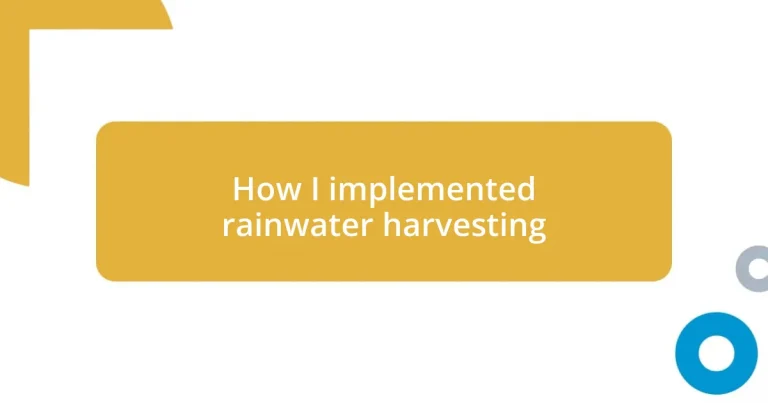Key takeaways:
- Rainwater harvesting systems effectively collect water for various uses, promoting sustainability and self-reliance.
- Selecting the right storage option (plastic, concrete, or barrels) enhances the system’s efficiency and water quality.
- Thorough planning, including roof assessment and understanding local regulations, is essential for successful installation.
- Regular maintenance, such as cleaning gutters and filters, ensures the longevity and quality of harvested rainwater.

Understanding rainwater harvesting systems
Rainwater harvesting systems are fascinating in their simplicity and effectiveness. Imagine collecting water from your roof during a rainstorm—it’s like capturing nature’s gift! The collected rainwater can be directed into storage tanks, which can then be utilized for irrigation, flushing toilets, or even drinking, depending on how it’s treated. It’s a beautiful cycle of reusing resources that often goes unnoticed.
When I first installed my rainwater harvesting system, I marveled at the transformation in my garden. I vividly recall how my once-dry soil eagerly soaked up the precious water during a dry spell, breathing life back into my plants. Isn’t it incredible how such a straightforward solution can yield such positive results? It’s striking what we can achieve when we harness natural processes instead of relying solely on municipal water supplies.
Additionally, understanding the components of these systems can deepen our appreciation for them. Filters, gutters, and downspouts all work together to capture and channel the rainwater effectively. Have you ever considered how much rain falls on your roof? For me, seeing those numbers painted a picture of potential—each drop collected represents a step toward sustainability and self-reliance.

Choosing the right rainwater storage
Choosing the right storage system for your rainwater is crucial for maximizing the benefits of your harvesting efforts. From my experience, various options exist, ranging from simple barrels to large underground tanks. Each choice has unique pros and cons that can influence how effective your rainwater system will be in the long run. When I first started, I went with a barrel—easy to install and more affordable. However, as my need for water grew, I wished I had invested in a larger system right off the bat.
The material and placement of your storage can also make a significant difference. For instance, I once opted for a plastic tank, which was lightweight and cost-effective. However, I quickly noticed it was prone to algae growth and lacked insulation from temperature fluctuations. I eventually upgraded to a concrete tank that offered better durability and temperature control, making a noticeable difference in water quality.
When narrowing down your options, it’s helpful to visualize the available space and intended use. Consider factors like storage capacity, maintenance requirements, and local climate conditions. For me, understanding these variables transformed my rainwater harvesting experience from a mere hobby into an essential aspect of my sustainability journey.
| Storage Type | Pros | Cons |
|---|---|---|
| Plastic Tank | Lightweight, Cost-effective | Prone to algae growth |
| Concrete Tank | Durable, Insulated | Expensive, Heavy |
| Rain Barrels | Easy to install, Affordable | Limited capacity |

Planning the installation process
When I began planning the installation of my rainwater harvesting system, I realized that thorough preparation would be critical to its success. I took the time to map out my roof’s drainage system and tried to visualize how the rainwater would flow, not unlike plotting a treasure map. I even jotted down a list of materials and steps to keep me organized.
Here’s what I focused on:
- Assessing Roof Size: I measured the area to estimate potential water catchment.
- Choosing Location: Deciding where to place the storage tank was important; I wanted it close to my garden but also easily accessible for maintenance.
- Evaluating Local Regulations: I researched any local laws regarding rainwater harvesting to ensure my project stayed compliant.
- Budgeting: I set a budget, keeping in mind both initial costs and any maintenance or upgrades I might need in the future.
Effective planning turned out to be a blend of practical choices and personal touches. One afternoon, I took a walk around my property, feeling the breeze and imagining how this simple system could transform my daily life. I could already picture my plants thriving, and it lit a spark of excitement in me! It truly felt like I was embarking on a journey towards greater sustainability and resilience.

Collecting rainwater effectively
To collect rainwater effectively, the first step is to focus on your gutter and downspout system. In my experience, installing a first-flush diverter was a game-changer. This device helps to prevent debris and contaminants from entering your storage tank, ensuring that the water you collect is as clean as possible. Have you ever noticed how much dirt collects on your roof? That initial runoff can really muddy things up if you’re not careful!
Next, I found that the slope and pitch of your roof can significantly impact how much water you collect. Mine has a steep pitch, which means I can capture a lot of rain with minimal effort. It’s fascinating to think about how a design that might seem purely aesthetic can also enhance function. I remember standing outside during a rainstorm, watching the water cascade into my barrels with such joy, feeling like I was tapping into a natural resource that was right above my head.
Lastly, ensuring that your collection system is properly sealed gives you peace of mind. When I first set up my barrels, I didn’t think much about covers. It was a pleasant surprise to find that once I added secure lids, I drastically reduced mosquito breeding and evaporation losses. The little things add up, don’t they? By taking these simple steps, you’ve not only improved the efficiency of your rainwater harvesting but also contributed positively to your surrounding environment.

Maintaining your rainwater system
Maintaining your rainwater system is crucial for its longevity and efficiency. I vividly remember the first time I noticed debris buildup in my gutters—it was a real eye-opener! Regularly clearing out leaves and twigs has become a routine for me, especially after heavy storms. It’s like taking care of a pet; if you neglect it just a little, things can quickly go awry.
Another essential aspect is checking the filters and screens that keep contaminants out of your rainwater. I once ignored this, thinking it wouldn’t make a difference, only to find that my stored water had an unpleasant smell. After that experience, I made it a habit to inspect them quarterly—it’s akin to spring cleaning, but for my water system. Keeping those filters clean not only ensures the quality of the water but also gives me a sense of satisfaction when I see how clear and fresh it stays.
Lastly, I’ve learned to keep an eye on my storage tank’s condition. A few months back, I noticed some rust forming on the exterior of my tank. That prompted me to paint it with a protective coating, which was a simple DIY project. It gave me a great sense of accomplishment, knowing I was extending the life of my investment. Have you ever felt that rush from a small maintenance job making a big difference? It’s rewarding to realize that by staying proactive, I can enjoy the benefits of my rainwater system for years to come.

Maximizing water quality safety
When it comes to maximizing water quality safety, I’ve found that effective filtration is absolutely crucial. I remember the first time I used a multi-stage filtration system; it completely transformed the clarity and taste of my harvested rainwater. I think it’s fascinating how something so simple can make such a difference. Have you ever tasted water that came straight from nature? It’s refreshing, and proper filtration ensures it remains that way.
I also prioritize using food-grade storage containers for my rainwater. Initially, I opted for whatever was available, not thinking much of it. But upon discovering that certain materials can leach harmful chemicals, I quickly made the switch to food-safe barrels. It adds peace of mind knowing that my water is stored safely, free from contaminants that could ruin not just the taste but also pose health risks. Isn’t it amazing how one choice can lead to a world of difference?
Additionally, regular water testing has become a routine part of my harvest practice. I was surprised to learn how easy and affordable it is to test water quality. It’s like a little health check-up for my rainwater—something I didn’t consider at first. When I started monitoring factors like pH levels and bacterial content, it not only gave me confidence in the water’s safety but also empowered me to make necessary adjustments. Have you ever taken a moment to check on the quality of something you assume is fine? You might be pleasantly surprised by what you discover!














